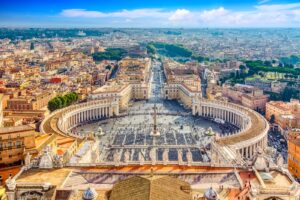In part one of this series, I addressed some objections to and questions about traditional urbanism, and identified some practical problems associated with post-1945 sprawl development. In this sequel, I address some questions about urbanism, modernity, and human nature.
Law professor Greg Sisk and Libertarian transportation consultant Randall O’Toole have argued that sprawl development is, on the whole, a welcome result of the modern economy, economic growth, and the possibility of upward mobility. They argue that walkable mixed-use urbanism is a remnant of stagnant economies and a way of life that modernity has rendered obsolete. Is this true?
The urbanist contention is that human beings should make walkable mixed-use settlements because such settlements accord with our social and embodied nature and will help us to flourish. The objection that walkable human settlements reflect historically contingent demographic patterns (and are therefore unnecessary) suggests one of two things: either 1) that modernity (more precisely: post-1945 sprawl development) has in some fundamental way changed our social and embodied human nature for the better; or 2) that human nature and human flourishing are not in some essential way related to our bodies. Neither of these propositions is true.
Let us suppose, though not too cavalierly, that mechanical means of transport are genuine goods, are not themselves a historically contingent aberration, and will be with us for the long term. Why would it still not be good to make walkable mixed-use settlements in which bicycles and cars and trains and airplanes are conveniences that supplement walking, rather than make single-use settlements that require mechanical means of transport for every one of life’s everyday activities? There is nothing “obsolete”—not least economically—about beautiful, low-rise, mixed-use walkable towns like Savannah and Santa Barbara and Cooperstown and Galena; or great low-rise city neighborhoods like Boston’s Beacon Hill, North End, and Back Bay, or Chicago’s Lincoln Park, places where even today real estate prices alone indicate their economic value. Nor was there anything economically or culturally stagnant about such medieval cities as Bruges or Florence or Oxford.
Start your day with Public Discourse
Sign up and get our daily essays sent straight to your inbox.Prosperity comes and goes, and every one of these aforementioned now thriving pre-modern cities and neighborhoods has at one time been poor. But one argument for building beautiful and durable walkable mixed-use places is that such places are able to endure physically through economic cycles. They may or may not be thriving neighborhoods now, but their building and spatial infrastructure always has the potential to be renewed. In contrast, we can be certain that the poorly built subdivisions and shopping malls of suburban sprawl have no long-term economic value, because they are both poorly built and inconvenient. This being the case, perhaps we should ask ourselves: are the choices and consumer goods afforded by the modern economy worth the price of a culture in which public places are unloved, and permanent things neither have value nor are represented and embodied in a durable public realm of buildings and spaces?
Does one have to be a metaphysical realist and believe in the natural law in order to be a traditional urbanist? Or, at least, in order to have an intellectually coherent view of traditional urbanism?
My brief answer to the former question is No, because there are any number of traditional urbanists who do not believe in the natural law; but to the latter question is Yes—if, as an urbanist, one holds that traditional urbanism is a genuine human good that really does promote human flourishing. Apart from metaphysical realism and natural law, I don’t see how this latter view of traditional urbanism as good can be defended except in emotivist and relativist terms—in other words, as ultimately anything more than subjective preference. Perhaps unsurprisingly, many if not most of my New Urbanist colleagues disagree; but that, I think, is because most New Urbanists fail to recognize the philosophical implications of the normative character of our own arguments. How so?
Alasdair MacIntyre, meeting with a group of my graduate urban design students, observed that contemporary moral discourse, both “liberal” and “conservative,” typically if unwittingly swings back and forth between pronunciations of Kantian categorical imperatives on the one hand and the articulation of Utilitarian exceptions on the other—the latter invariably having to do with defenses of either the modern growth economy, national defense, or the protection and exercise of individual (most typically sexual) autonomy. The inherent irresolvability of the disputes that characterize modern moral discourse (whether about war, the economy, nature, or abortion) mark that discourse’s subjective and emotivist nature, and reveal it to be deeply incoherent. A more coherent moral discourse, one understood less in terms of absolute rules and subjectively determined exceptions and more in terms of character ideals, judgment and good habits, would understand that virtues, goods, and the good imply (and in fact require) a teleological view of human nature—which is precisely what modern liberal culture by definition lacks.
The New Urbanist case for traditional urbanism is grounded in an implicitly substantive view of human nature, and is prima facie not a subjectivist argument. New Urbanists observe correctly that traditional towns and urban neighborhoods demonstrate historically that they promote human flourishing and reflect human sociability, and that such places both support and are supported by the free exchange of ideas and material goods (including private property). For the sake of both the human animal and the natural environment that sustains human animals, New Urbanists fight for compact, walkable, mixed-use, and mixed-income communities that inhabit a public realm of plazas, squares, and pedestrian-friendly streets, in the proximity of open landscapes. The pursuit of this effort marks the Congress for the New Urbanism as a classic American Tocquevillian association, one that pursues a public good and performs a public service.
Nevertheless, some New Urbanists reveal their residual modernist assumptions about human nature in their unwillingness or inability to argue that human beings have a telos, that the good life for human beings has a minimally substantive content necessarily related to moral and intellectual virtue, and that traditional urbanism itself calls into question the culture of modern individualism in both its “liberal” and “conservative” manifestations. This may explain the enthusiasm of some New Urbanists for expansive national and international solutions to the problems of sprawl, as if legal solutions are not merely a necessary element but also a sufficient remedy for an essentially cultural problem. This occasional enthusiasm for large-scale political prescriptions, combined with our reluctance or inability to articulate a coherent account of human nature, makes New Urbanists vulnerable to the charge that we ourselves harbor the old determinist conceit of Modernist architects and urbanists that a well-built environment will make people good—as if human beings are manipulable objects rather than free persons with wills of their own, capable of reason and subject to rational persuasion. Without a substantive anthropological argument to the contrary, New Urbanists should not be surprised to find ourselves recurringly subject to accusations from the Libertarian right that we are architectural determinists and social engineers—and, as tellingly, from the political left that New Urbanism panders to consumers.
This reluctance or inability of New Urbanists to articulate and embrace a substantive view of human nature and human well being contrasts markedly with the New Urbanist view of nature itself as something objective—i.e., as something real, of which human beings are part and to which we have a certain responsibility. The Congress for the New Urbanism from its founding has promoted the beneficial environmental consequences of traditional urbanism, but this enthusiasm for a stewardship-and-conservationist ethos masks an anthropological ambivalence at the heart of New Urbanist theory. Just as New Urbanists publicly and famously take no substantive communal position on matters of architecture and construction, more quietly do we avoid a substantive communal position on matters of human sociability and human nature, including most especially the relationship between human freedom, human obligation, and human well being. And yet both aesthetics and human nature are issues that New Urbanists cannot avoid forever, not least because a subjectivist view of both aesthetics and morality may be irreconcilable with an argument for the objective goods of traditional urbanism.
New Urbanist indifference to or confusion about metaphysical realism and virtue ethics notwithstanding, there are natural law inferences that can be drawn from the beliefs and behaviors even of ordinary modern emotivists, even those who imagine themselves moral relativists and multi-culturalists. For example, if one thinks adults really should take care of their children and their elderly parents; if one thinks it really is wrong to intentionally harm the innocent; if one really does think human beings best flourish in mixed-use walkable settlements, one already believes implicitly in the natural law. But we’re talking here about deep cultural and intellectual divisions; and realistically, there is probably no reason to think that virtue ethics and natural law arguments will prevail any more quickly (or slowly) than a culture-wide normative re-establishment of traditional urbanism itself.
Finally, is there a necessary relationship between living in a traditional urban environment and the acquisition of those good character habits we call virtues?
This question—which also asks whether and in what way it is possible to assert truly that traditional urbanism is a genuine moral imperative—is one to which a strong declarative No requires immediate qualification, because even though good urbanism cannot “make people good,” it nevertheless seems true that certain kinds of environments facilitate certain kinds of behavior. Thus, for example, have Catholic teachers, parents, and moralists often encouraged their charges to avoid certain environments as “proximate occasions of sin.” Can we not correctly infer that there are also certain kinds of environments that may be proximate occasions of goodness? Let us grant that beautiful, traditional urban environments are themselves the product of communities to which certain moral and intellectual virtues are central; and, also, that such environments cannot cause their individual inhabitants to be virtuous. It nonetheless may be true, all things being equal, that moral and intellectual virtue is better promoted in traditional urban environments than in suburban sprawl environments.
Our everyday language makes a prima facie case that this is so. Human beings who are civilized, urbane, polite, and polished are being described by words more or less closely associated with Greek or Latin words for city; and all urban cultures from which these words were derived were walkable mixed-use settlements of streets, blocks, squares, religious and civic foreground buildings, and private background buildings. The relationship need not be causal, but it does raise the question: does such an environment, characterized by a compact proximity of both activities and people across classes and generations, better promote the virtues than environments lacking such characteristics? Again, without suggesting there are no virtuous persons in suburbia, nor persons deficient in virtue in traditional towns and cities (after all, our literature of virtue is full of references to wicked cities), let me nevertheless hypothesize that, all other things being equal, traditional urbanism better promotes the virtues than does sprawl. And here let me see if I can illuminate this point with an analogy.
Several years ago, a friend and I went to see an Illinois state high school football quarter-final playoff game that pitted the top-ranked Chicago-city public high school against a suburban-Chicago public high school from the DuPage Valley Conference, which year-in and year-out produces at least one and sometimes as many as three teams that compete in the semi-finals of the big-school divisions, and wins a statistically disproportionate share of state championships. (In contrast, few Chicago public schools have made it past the quarter-finals for several decades.) That night, however, the very best football player on the field was from the Chicago-city public school: a 6’-5”, 245-pound junior defensive end and future Division I star who seemed to spend the entire night in the suburban team’s backfield. He had at least five quarterback sacks, numerous near sacks, and was in on well over half his team’s tackles. He was always around the ball; he played as a man among boys. And yet the suburban team won the game—by five touchdowns. Here is my point: the Chicago-city public school defensive end was clearly and objectively a good football player; nevertheless, the football culture of the DuPage Valley Conference is clearly and objectively more conducive to producing good football teams and good football players than is the football culture of the Chicago public schools.
I am conscious of the irony that in the culture of high school football, suburban public schools are more successful at producing good football teams than are urban public schools. (Had I chosen the example of high school basketball, the urban and suburban roles would arguably be reversed.) And I grant that in contemporary American culture, it is much easier to agree upon what kind of community best produces good high school football teams and players than to agree upon what kind of community best succeeds in producing good human beings who flourish over the course of a whole life and for generations. Nevertheless, I hope this analogy helps suggest how, in traditional towns and neighborhoods, the sheer propinquity of both people and communal practices—bearing in mind that communal practices are the greenhouses of moral and intellectual virtue—make such places more conducive to human beings acquiring the virtues we all need for a good life than environments lacking such propinquity of both people and communal practices.
A colleague of mine likes to say that whatever the talent of a student, a good education in classical architecture makes good architectural design easier and bad architectural design more difficult. But what is true of architectural education in particular is also true of traditional urbanism: traditional towns and neighborhoods exist to make the good easier, and the bad more difficult. And what is true of architecture and urbanism is true of culture generally: the good is made easier by the acquisition of those good fixed character habits we call virtues, and the bad is made more difficult by the pains of a well-formed conscience. The built environment can neither determine behavior nor cause happiness. But insofar as the built environment embodies moral intent—and it does—we err in regarding it as a matter of moral indifference. Human beings should make walkable mixed-use settlements.














